|
| Page: [Previous] [Next] 1 2 |
| (1) Posted by Zalmen Kornin [Monday, Jul 16, 2007 18:48] |
Pawn becoming Queen as key
Pawn becoming Queen as Key
Whe we essay to define what should be considered as a ‘good’ or even an ‘excelent’ key, to transform a Pawn in Queen would be, of course, one of the first moves to be disdained: The increased mobility of the new piece is so ostensible, that we will find, in the litterature, the move ‘Pawn eight equal Queen’ appearing, almost exclusively, as try: the strongest coronation defeated by Black in a quite subtle way, and the solver having to find another path for the fulfilment of the proposition... Then a good advice for the novice is – “avoid the CRUDE P=Q as key” – But... (in Chess composition , it seems that a ‘but’ make it’s appearence always when we declare something categorically...) BUT:
W. Pauly “The Theory of Pawn Promotion” 1912
 (= 9+5 ) (= 9+5 )
Mate in Three Moves #3
Pauly, who created an impressive series of Problems featuring underpromotion, presents now 1.a8=Q!! – not only defending ‘f8’, but also threatening Qe8-f7 (or Bf7) – The point come after the defenses 1...cd6 and 1...c5 – the force of the new Queen must to be masked in a striking way!
In Helpmates, to promote a Pawn to Queen in order to sacrifice the new piece during the solution is a very esteemed trick – but one of the leading H# composers present, for our delectation, following:
G. Paros “Magyar Sakkélet” 1955 I Pr.
 (= 3+6 ) (= 3+6 )
h#6 0.1 ... (helpmate in six, white to play)
Here an echo in the first and the last white moves is blended with other pleasant features...
(I would appreciate if other examples in this topic arrived to be presented here – Thanks)
Posted: Thu Aug 25, 2005 6:33 am
*****This was an article from that ill-fated Problems Forum, from where I can not find currently any trace on-line, not even ‘in cache’.
Therefore I can paste here only my initial post, and that because I have it (still) in my archives – There was some answers, from which I retained only a highly interesting four-mover presented by a Dutch chess problems friend, who was very assiduous there (an invaluable contribution, as this Problem was not on-line in other places)::
T. Siers
“Herdfeuer” 1934
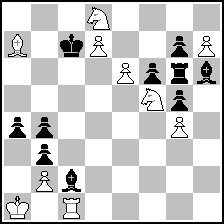 (= 10+10 ) (= 10+10 )
#4
.....
|
|
| (2) Posted by Aleksey Oganesjan [Wednesday, Dec 4, 2019 11:57]; edited by Aleksey Oganesjan [19-12-04] |
This is my recent example on this subject:
Aleksey Oganesjan
TT-208, SuperProblem, 2018
2nd HM
 (= 8+8 ) (= 8+8 )
#3
1.a8Q! zz
1...Sa6 2.Qxb2+! Kxb2 3.Qh8#
1...Sd7 2.Qxa2+! Kxa2 3.Qa8#
1...cxb5 2.Rxb1+! Kxb1 3.Qh1#
"The key is necessary but too strong" - these are words of TT judge (Grigory Atayants), with which one cannot but agree.
|
|
| (3) Posted by seetharaman kalyan [Wednesday, Dec 4, 2019 13:08] |
Nice. Rare queen-queen zilahi i think
|
|
| (4) Posted by Hauke Reddmann [Wednesday, Dec 4, 2019 13:44] |
I can post an example after the SCHWALBE 228 TT is through.
Meanwhile (can find it offhand) the only Punk problem ever:
1.gxh8Q=Q+ (check, takes flight ...but it's "White to play" :-)
|
|
| (5) Posted by Geoff Foster [Thursday, Dec 5, 2019 01:18] |
The following example has a triple Grimshaw.
Vitaly & Sergei Pimenov
3 Prize, BCF Ty 1929-30
 (= 10+10 ) (= 10+10 )
#2
1.g8=Q! (>2.Qd5)
1...Bb4 2.Qc4
1...Rb4 2.Qxc5
1...Bf3 2.Be3
1...Rf3 2.Se2
1...e6 2.Qgd8
1...Be6 2.Qg7
|
|
| (6) Posted by Geoff Foster [Thursday, Dec 5, 2019 01:49] |
In the following example the aim is stalemate. The twinning is consecutive, which means that each change is made to the previous position.
Gerhard Maleika
2 HM The Problemist 2014 (section 2)
 (= 8+2 ) (= 8+2 )
=2
(b) -Pc7
(c) & -Pd7
(d) & -Pe7
(e) & -Pf7
(a)
1.c8=Q!
1...Sc2 2.Sxc2
1...Sb3 2.Qb7
(b)
1.d8=Q!
1...Sc2 2.Qdd3
1...Sb3 2.Qb6
(c)
1.e8=Q!
1...Sc2 2.Qe4
1...Sb3 2.Qb5
(d)
1.f8=Q!
1...Sc2 2.Qf5
1...Sb3 2.Qfb4
(e)
1.g8=B!
1...Sc2 2.Bh7
1...Sb3 2.Bxb3
The judge, Julia Vysotska, commented: "A highly amusing 5x2 change of variations in the form of striptease twins. The first and the last twins break the rather mechanical concurrent play, while the perfect construction makes a memorable impression. A problem to amuse."
|
|
| (7) Posted by Olaf Jenkner [Thursday, Dec 5, 2019 22:30] |
In this selfmate the author used the promotion to avoid a promoted piece in the position:
http://pdb.dieschwalbe.de/search.jsp?expression=probid=%27P1202220%27
|
|
| (8) Posted by Joaquim Crusats [Friday, Dec 6, 2019 08:07]; edited by Joaquim Crusats [19-12-06] |
It's always a dilemma. In the following example I used 1.h8=Q! as a key in order to show the first tripled Lepuschütz.
The matrix would allow a much better logical problem in which the theme would be only doubled, but since there were excellent problems already published I leaned towards the triple realization. I remember that it required a lot of work to find a way to rule out 1.h8=R! as a cook (note that in the next moves a wR does suffice).
Joaquim Crusats
Schack Aktiv 2010
 (= 13+12 ) (= 13+12 )
#8
Solution: 1.h8=Q Rxh8+ 2.Rd8 Rh2 3.Rh8 Rxh8+ 4.Rc8 Rh2 5.Rh8 Rxh8+ 6.Kc7 Rh2 7.Sh5+ Rxh5 8.Bxb6 Ra7+ 9.Bxa7 ~ 10.Be3#
|
|
| (9) Posted by Hauke Reddmann [Friday, Dec 6, 2019 14:21] |
Related: I think it was a Brunner problem where a Plachutta (??)
between two black Q was shown. A commenter (Grasemann??) said
he could as well have been so bold and drop the first move
pair 1.whateveritwas g1Q.
|
|
| (10) Posted by James Malcom [Saturday, Dec 7, 2019 03:11] |
Of course, there a task by Zalmen themselves that is the only orthodox #4 I know of that has a promotion as the key. Drumare does a a #5 with such a key that is based his on earlier illegal #5.
Zalmen Kornin
Problemesis, 2005
#4
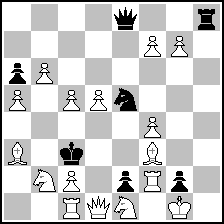 (= 16+7 ) (= 16+7 )
|
|
| (11) Posted by Geoff Foster [Saturday, Dec 7, 2019 22:43] |
Perhaps this is the problem that Hauke was thinking of?
Johannes Kohtz & Carl Kockelkorn
Akademisches Monatsheft fur Schach 1896 (v)
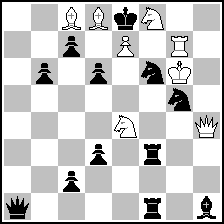 (= 8+12 ) (= 8+12 )
#5
1.Rg8! c1=Q 2.Sc3 (>3.Se6+ Sxg8 4.Sxc7,Sg7)
2...Qaxc3 3.Qc4
2...Qcxc3 3.Qd4
|
|
| (12) Posted by Sarah Hornecker [Sunday, Dec 8, 2019 20:50] |
Of course, Yours Truly also used such a key when necessary. I believe this was the first perfect rendition of the Four Corners queen in a kindergarten setting?
http://matplus.net/start.php?px=1575834419&app=forum&act=posts&fid=xshown&tid=696
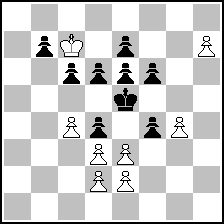 (= 8+9 ) (= 8+9 )
Siegfried Hornecker & Gilles Regniers
chessproblem.net, 13th February 2009 (also: Horizon 103, July 2009)
Mate in 5
|
|
| (13) Posted by Jacques Rotenberg [Monday, Dec 9, 2019 15:28]; edited by Jacques Rotenberg [19-12-09] |
btw, the file quoted by Siegfried contains another "pawn becoming queen as a key"
Jean-Marc Loustau
Jacques Rotenberg
Die Schwalbe 1986
1st Prize
 (= 10+13 ) (= 10+13 )
7#
1.e8=Q! [2.Q×e5‡] a1=Q 2.Qfe7! [3.Q×e5+ Q×e5 4.Q×e5‡] (2.d4? Qxd4! 3.Qc5+ Qxc5+!)
2...Bd4 3.Q8f8 [4.Qc5+,Q×e5+] Qg1 4.Qee8 [5.Qç5+ B×ç5 6.Q×e5‡]
4...Ba1 5.d4! [6.Q×e5,Qc5‡]
5...Q×d4 6.Q×e5+ Q×e5 7.Qç5‡
5...B×d4 6.Qc5+ B×c5 7.Q×e5‡
4...Qf5 5.Qf×f7+! S×f7 6.Q×f7+ Kd6 7.Be7‡
|
|
| (14) Posted by Michael McDowell [Monday, Dec 9, 2019 17:17] |
I'd have thought this was probably the most famous problem with a P=Q key:
Friedrich Kohnlein
Deutsches Wochenschach 1903
 (= 11+4 ) (= 11+4 )
Mate in 4
1.f8Q Kb4 2.h8B Kxc5 3.b8R Kd6 4.c8S; 2...Ka4 3.Bc3 and 4.Qa8
1...Kd2 2.Qf2+ Kc3 3.Qe1+ Kd4 4.Bg1
|
|
| (15) Posted by Jacques Rotenberg [Tuesday, Dec 10, 2019 00:17]; edited by Jacques Rotenberg [19-12-10] |
or this one ?
Knud Hannemann
Skakbladet 1935
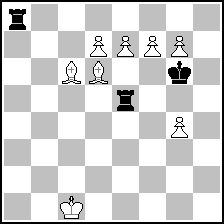 (= 8+3 ) (= 8+3 )
5#
1.g8=Q+! R×g8 2.f×g8=R+! Kf6 3.e8=S+! R×e8 4.d×e8=B! [5.Rg6‡]
3…Kf7 4.Rg7+
2…Kh7/Kh6 3.B×e5
1.g8=R+? Kxf7!
1.Bxe5? Ra1+!
|
|
| (16) Posted by Hauke Reddmann [Tuesday, Dec 10, 2019 17:49] |
@Geoff: Same theme, as it seems, but not the
one I (don't :-) remember.
In the meantime I found the punk rock #2:
https://www.yacpdb.org/#295577
|
|
| (17) Posted by Aleksey Oganesjan [Thursday, Dec 19, 2019 18:47]; edited by Aleksey Oganesjan [19-12-20] |
And now - my fresh examples:
Aleksey Oganesjan
"64", 12/2019
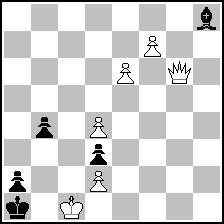 (= 6+5 ) (= 6+5 )
#4
1.f8Q! Bxd4 2.Qxb4!
2...Bh8 3.Qg5! zz 3...B~ 4.QxB#
2...Be5 3.Qh6! zz 3...B~ 4.QxB#
A variety of well-known Loyd's "Love chase". Here not one but two Dames (Queens) catch an Officer (Bishop), at that without attacking him in the final!
---
Aleksey Oganesjan
Moscow tourney, 2019, Comm.
 (= 6+6 ) (= 6+6 )
#3 b) Ph6->h5
a) diagram:
1.f8Q? Be5! zz 2.Qfe7/Qf7? Bh8!, 2.Qd8? Bg7!, 2.Qg8? Bf6!, 2.Qa3/Qb3? Bd4!, 2.Qb6? Bc3!, 2.Qbc5/Qc4? Bb2+!
1.e5! Bxe5 2.f8Q! zz 2...B~ 3.QxB#
b) Ph6->h5:
1.e5? Bxe5 2.f8Q h6! zz or 1.h6? Bf6! 2.f8Q Be5! zz
1.f8Q! Be5 2.h6! zz 2...B~ 3.QxB#
Domination and mutual zugzwang.
|
|
| (18) Posted by James Malcom [Thursday, Dec 19, 2019 18:55] |
Interesting problems Aleksey,
Also, I just remembered this problem.
Миљанић, Мирко
Mat Plus, Dec 1996
#122
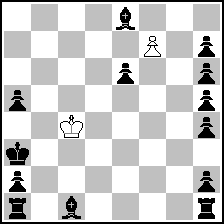 (= 2+13 ) (= 2+13 )
|
|
| (19) Posted by Joose Norri [Thursday, Jan 2, 2020 17:12] |
Here the king walks into a fivefold pin.
Fernand Joseph & Jean Helbig
1. Pr. Probleemblad 136. TT, 1977
 (= 11+9 ) (= 11+9 )
|
|
| (20) Posted by James Malcom [Thursday, Jan 2, 2020 18:51] |
Another amazing task with queen promotion as a key.
Grigory Popov
1st Special Prize
SuperProblem, 3 Feb 2014 (C003)
#11
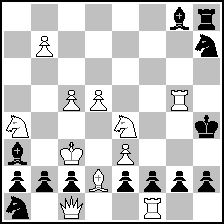 (= 11+13 ) (= 11+13 )
|
|
Read more... |
Page: [Previous] [Next] 1 2
MatPlus.Net  Forum Forum  RebNora recovered texts RebNora recovered texts  Pawn becoming Queen as key Pawn becoming Queen as key |
 ISC 2024
ISC 2024 Forum
Forum  RebNora recovered texts
RebNora recovered texts  Pawn becoming Queen as key
Pawn becoming Queen as key 


